We’re back from our four-day 4th of July weekend. While my weekend wasn’t exactly restful, it was very fun. I volunteered at Camp Smiles, a summer camp for kids with cerebral palsy at Camp for All in Burton, Texas, one of my favorite places in the world. After a sleepless four days, it was time to jump back in to the most fun part of the engineering design process: prototyping.
Like usual, we started with low fidelity prototypes. First we prototyped the scissor lift and base out of cardboard and toothpicks.
Then, after determining the dimensions of our final design, we made another low-fidelity prototype, this time at half scale. The materials used in this prototype were straws, cardboard, popsicle sticks, and play-doh. Besides some bending of the cardboard, the scissor mechanism of this prototype was functional. On this prototype, we also built the rails that will connect the lift to the seat.
We also prototyped the seat, which will include movable armrests, adjustable footrests, a foldable back, and straps. The footrests will allow the person being transferred to help more with the transfer using their legs, and the straps will stabilize the person being transferred, which is especially important if the person does not have good trunk control. In addition to components found in the seat of a typical wheelchair, the seat will also include an attached sliding board that can be slid out of the device on either side. This will help make the transfer easier, stabilize the sliding board, and prevent the caregiver from having to carry around both the device and an additional sliding board.
We then made a low-fidelity prototype of the crank mechanism from cardboard, a bolt, and a nut. As you spin the crank, the nut attached to the beam moves down the screw, pushing the scissor lift up. However, after making this prototype, we realized that when the crank is turned clockwise, the scissor lift will lower instead of raise, which is against our intuition. Therefore, Bruno made us a 3D printed prototype of the same mechanism, this time with the threads on the screw and in the nut reversed. This way the lift raises when the crank is turned clockwise.
From here we decided to move on to a medium fidelity prototype. We laser-cut many of the components of this prototype since it is easy, fast, and accurate. Some features of this prototype were rails for the end of the scissor lift and dowels to connect the two sides of the lift.
Today we also presented our mid-internship presentations. Each team presented about their problem and proposed solution to that problem. It was so interesting to hear about each team’s chosen solution and how they will fix the errors of previous solution attempts.
This morning we received the a motorcycle scissor lift we had ordered. This lift started at 13 inches and rose to 34 inches, which is almost exactly what we had desired in our design criteria. It also lifts over 300 pounds and weighs about 60 pounds. However, this lift is pumped up by a hydraulic foot pump, which is undesirable for us due to its price. Therefore, while this device is well-made and helpful, we cannot simply attach a seat to it as-is.
Our plan moving forward is to modify the scissor lift that we bought, since we do not have the skills or time to make one of such a high quality ourselves. Tomorrow we will start a medium-fidelity prototype of the chair, and continue modifying the scissor lift to reduce its weight and install the screw. While I was somewhat discouraged this morning since all of the other teams seem to have extremely feasible and promising solutions, the arrival of our scissor lift boosted my confidence a great deal, since my main concern was how we were going to build our own stable scissor lift. I’m excited to continue with our prototype and am hopeful that we will be able to deliver an extremely helpful solution.

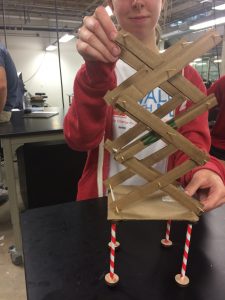
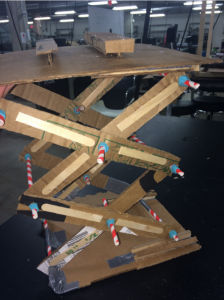
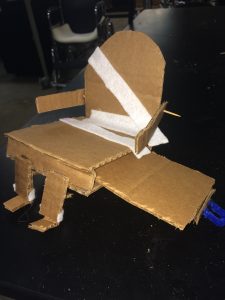
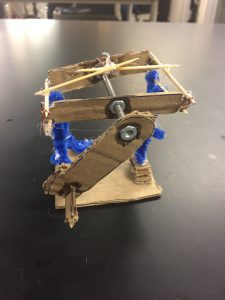
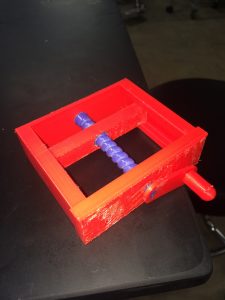
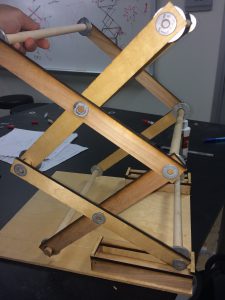
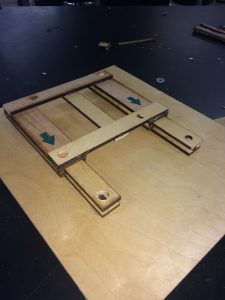
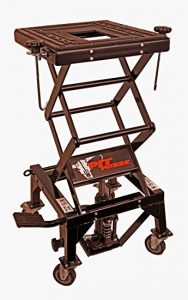
Don’t be discouraged by what other teams seem to be achieving. Part of engineering design is set-backs leading to the need to rethink and modify. How well you handle such challenges is of vital importance.
Harrell suggests that when you load the device with 200 lbs. it will make it more difficult to hand crank, so be sure to test it with weight.
Thank you so much for the advice and suggestion. We will definitely include weight in our testing of our “ease of use” objective.